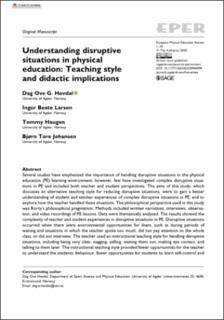| dc.contributor.author | Hovland, Dag Ove | |
| dc.contributor.author | Larsen, Inger Beate | |
| dc.contributor.author | Haugen, Tommy | |
| dc.contributor.author | Johansen, Bjørn Tore | |
| dc.date.accessioned | 2023-06-06T11:14:31Z | |
| dc.date.available | 2023-06-06T11:14:31Z | |
| dc.date.created | 2020-10-08T13:43:28Z | |
| dc.date.issued | 2020 | |
| dc.identifier.citation | Hovland, D. O., Larsen, I. B., Haugen, T. & Johansen, B. T. (2020). Understanding disruptive situations in physical education: Teaching style and didactic implications. European Physical Education Review, 27(3), 455-472. doi: | en_US |
| dc.identifier.issn | 1356-336X | |
| dc.identifier.uri | https://hdl.handle.net/11250/3070121 | |
| dc.description.abstract | Several studies have emphasized the importance of handling disruptive situations in the physical education (PE) learning environment; however, few have investigated complex disruptive situations in PE and included both teacher and student perspectives. The aims of this study, which discusses an alternative teaching style for reducing disruptive situations, were to gain a better understanding of student and teacher experiences of complex disruptive situations in PE, and to explore how the teacher handled these situations. The philosophical perspective used in this study was Rorty’s philosophical pragmatism. Methods included written narratives, interviews, observation, and video recordings of PE lessons. Data were thematically analysed. The results showed the complexity of teacher and student experiences in disruptive situations in PE. Disruptive situations occurred when there were environmental opportunities for them, such as during periods of waiting and situations in which the teacher spoke too much, did not pay attention to the whole class, or did not intervene. The teacher used an instructional teaching style for handling disruptive situations, including being very clear, nagging, yelling, waiting them out, making eye contact, and talking to them later. The instructional teaching style provided fewer opportunities for the teacher to understand the students’ behaviour, fewer opportunities for students to learn self-control and personal and social responsibility, and did not lead to a reduction of disruptive situations over the data creation period. The practical consequence of this teaching style seemed to be the frequent use of behaviour corrections for reducing disruptive situations. | en_US |
| dc.language.iso | eng | en_US |
| dc.publisher | Sage Publications | en_US |
| dc.rights | Navngivelse 4.0 Internasjonal | * |
| dc.rights.uri | http://creativecommons.org/licenses/by/4.0/deed.no | * |
| dc.title | Understanding disruptive situations in physical education: Teaching style and didactic implications | en_US |
| dc.type | Peer reviewed | en_US |
| dc.type | Journal article | en_US |
| dc.description.version | acceptedVersion | en_US |
| dc.rights.holder | © 2020 The Author(s) | en_US |
| dc.subject.nsi | VDP::Samfunnsvitenskap: 200::Samfunnsvitenskapelige idrettsfag: 330 | en_US |
| dc.subject.nsi | VDP::Medisinske Fag: 700::Idrettsmedisinske fag: 850 | en_US |
| dc.source.pagenumber | 455-472 | en_US |
| dc.source.volume | 27 | en_US |
| dc.source.journal | European Physical Education Review | en_US |
| dc.source.issue | 3 | en_US |
| dc.identifier.doi | 10.1177/1356336X20960498 | |
| dc.identifier.cristin | 1838221 | |
| cristin.qualitycode | 1 | |

